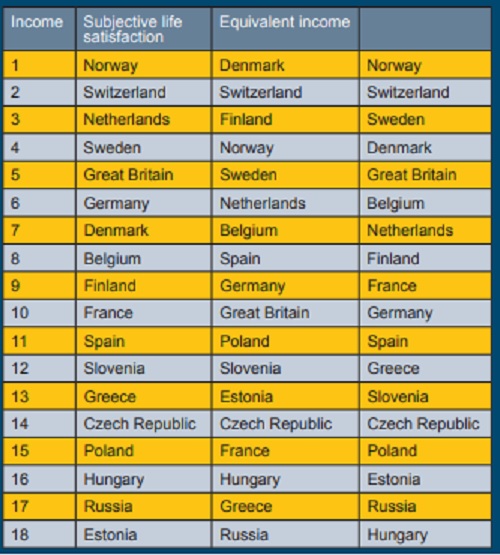
And why it may be an element in evaluating one’s well-being, but it is not the only one
Kampala, Uganda | HENRY S. RICHARDSON & ERIK SCHOKKAERT | Opinions differ on the definition of well-being. Yet there’s a growing consensus that it cannot be reduced to material consumption and that other aspects of life, such as health and good social relations, are essential to being well.
Increasing well-being is generally accepted as one of the essential components of social progress, but if different aspects of life all contribute to well-being, can or should we construct an overall measure of it? For example, is “happiness” a good measure?
Before we can begin to monitor social progress in terms of well-being, we need more clarity on the concept itself.
Measuring happiness
One possibility is to use large opinion surveys in which individuals answer simple questions on their degree of happiness or life satisfaction. These have revealed robust patterns, confirming that economic growth has a weaker than expected effect on satisfaction, and that other aspects of life, such as health and unemployment, are important.
These simple survey measures seem credible. But according to psychologists, happiness and life satisfaction do not coincide. Life satisfaction has a cognitive component – individuals have to step back to assess their lives – while happiness reflects positive and negative emotions that fluctuate.
A focus on positive and negative emotions can lead to understanding well-being in an “hedonic” way, based in pleasure and the absence of pain. Looking instead to individuals’ judgements about what is worth seeking suggests a preference-based approach (a possibility we discuss below). People judge all sorts of different things to be worth seeking.
In other words, happiness may be an element in evaluating one’s well-being, but it is not the only one.
The capability approach
Nobel Prize winner Amartya Sen has pointed out that understanding well-being on the basis of feelings of satisfaction, pleasure, or happiness have two problems.
The first he calls “physical-condition neglect”. Human beings adapt at least partially to unfavourable situations, meaning the poor and the sick can still be relatively happy. One striking study by a team of Belgian and French physicians has shown that even in a cohort of patients with chronic locked-in syndrome, a majority reported being happy.
The second problem is “valuation neglect”. Valuing a life is a reflective activity that should not be reduced to feeling happy or unhappy. Of course, Sen admits, “it would be odd to claim that a person broken down by pain and misery is doing very well”.
We should therefore not fully neglect the importance of feeling well, but also acknowledge it is not the only thing people care about.
Together with Martha Nussbaum, Sen formulated an alternative: the capability approach, which stipulates that both personal characteristics and social circumstances affect what people can achieve with a given amount of resources.
Giving books to a person who cannot read does not increase their well-being (probably the opposite), just as providing them with a car does not increase mobility if there are no decent roads.
According to Sen, what the person manages to do or to be – such as being well-nourished or being able to appear in public without shame – are what really matter for well-being. Sen calls these achievements the “functionings” of the person. However, he further claims that defining well-being only in terms of functioning is insufficient, because well-being also includes freedom.
His classic example involves the comparison between two undernourished individuals. The first person is poor and cannot afford food; the second is wealthy but chooses to fast for religious reasons. While they achieve the same level of nourishment, they cannot be said to enjoy the same level of well-being.
Therefore, Sen suggests that well-being should be understood in terms of people’s real opportunities – that is, all possible combinations of functionings from which they can choose.
The capability approach is inherently multidimensional; but those seeking to guide policy often think that rationally dealing with trade-offs requires having one single ultimate measure. Adherents of the capability approach who succumb to this thought often mistrust individual preferences and apply instead a set of indicators that are common to all individuals.
So-called “composite indicators” – like the United Nations’ Human Development Index, which adds together consumption, life expectancy and educational performance at the country level – are a frequent outcome of this kind of thinking. They have become popular in policy circles, but they fall victim to simply adding up scores on different dimensions, all deemed equally important.
Taking individual convictions seriously
Beyond the subjective approach and the capability approach, a third perspective – the preference-based approach to well-being – takes into account that people disagree about the relative importance of different life dimensions.
Some people think that hard work is necessary to have a valuable life while others prefer to spend more time with family. Some think that going out with friends is key, while others prefer reading a book in a quiet place.
The “preference-based” perspective starts from the idea that people are better off when their reality matches better what they themselves consider to be important.
Preferences thus have a cognitive “valuational” component: they reflect people’s well-informed and well-considered ideas about what a good life is, not merely their market behaviour.
This does not coincide with subjective life satisfaction. Recall the example of patients with the locked-in syndrome reporting high levels of satisfaction because they have adapted to their situation. This does not mean that they would not prefer to have their health back – and it certainly does not mean that citizens without locked-in syndrome would not mind falling ill with it.
One example of a preference-based measure, advocated by the French economist Marc Fleurbaey, directs people to choose reference values for all non-income aspects of life (such as health or number of hours worked). These reference values will depend on the individual: everyone probably agrees that not being ill is the best possible state, but a workaholic lawyer is likely to place a very different value on work hours than someone with an arduous and hazardous factory job.
Fleurbaey then suggests that people define a salary that, combined with the non-income-based reference value, would satisfy the individual as much as their current situation.
The amount by which this “equivalent income” differs from the person’s actual work-based income can help answer the question: “How much income you would be willing to give up for better health or more free time?”
Some psychologists are sceptical about preference-based approaches because they assume that human beings have well-informed and well-considered ideas about what makes a good life. Even if such rational preferences exist, one struggles to measure them because these are aspects of life – family time, health – that are not traded on markets.
Does all this matter in practice?
The following table, compiled by the Belgian economists Koen Decancq and Erik Schokkaert, shows how differing approaches to well-being can have practical consequences.
It ranks 18 European countries in 2010 (just after the financial crisis) according to three possible measures: average income, average life satisfaction and average “equivalent income” (taking into account health, unemployment, safety and the quality of social interactions).

Some results are striking. Danes are much more satisfied than they are wealthy, while France is the opposite. These large divergences are not seen when comparing equivalent incomes, however; which suggests that satisfaction in these two countries is heavily influenced by cultural differences.
Germany and the Netherlands also do worse on satisfaction than on income, but their equivalent income rankings confirm that they do relatively worse on the non-income dimensions.
Greece has a remarkably low level of life satisfaction. Cultural factors may play a role here, but Greece is also characterised by high income inequality, which is not captured by the averages in the table.
These differences among various measures of well-being hint at the important issues involved in deciding which measure of well-being – if any – to select. If we want to use the measure to rank nations’ performance at providing well-being, then we will be pulled towards a single, simple measure, such as subjective happiness. If we seek to keep track, for policy purposes, of whether individuals are doing well in the respects that really matter, we will be pulled towards a more multi-dimensional assessment, such as that offered by the capability approach. And if we are most impressed by disagreement among individuals as to what matters, we will have reason to understand well-being along the lines suggested by the preference-based approach.
This post belongs to a series of contributions coming from the International Panel on Social Progress, a global academic initiative of more than 300 scholars from all social sciences and the humanities who prepare a report on the perspectives for social progress in the 21st Century. In partnership with The Conversation, the posts offer a glimpse of the contents of the report and of the authors’ research.
*****
Henry S. Richardson is professor of Philosophy, Senior Research Scholar, Kennedy Institute of Ethics, Georgetown University and Erik Schokkaert is Professor of Economics, KU Leuven.
 The Independent Uganda: You get the Truth we Pay the Price
The Independent Uganda: You get the Truth we Pay the Price



